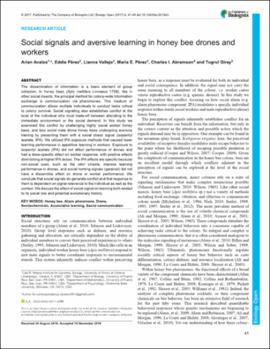| dc.contributor.author | Avalos, Arian | |
| dc.contributor.author | Perez, Eddie | |
| dc.contributor.author | Vallejo, Lianna | |
| dc.contributor.author | Perez, Maria E. | |
| dc.contributor.author | Abramson, Charles I. | |
| dc.contributor.author | Giray, Tugrul | |
| dc.date.accessioned | 2018-09-21T17:51:35Z | |
| dc.date.available | 2018-09-21T17:51:35Z | |
| dc.date.issued | 2017 | |
| dc.identifier | oksd_avalos_socialsignalsan_2017-07-15 | |
| dc.identifier.citation | Avalos, A., Perez, E., Vallejo, L., Perez, M. E., Abramson, C. I., & Giray, T. (2017). Social signals and aversive learning in honey bee drones and workers. Biology Open, 6, 41-49. https://doi.org/10.1242/bio.021543 | |
| dc.identifier.uri | https://hdl.handle.net/11244/301766 | |
| dc.description.abstract | The dissemination of information is a basic element of group cohesion. In honey bees (Apis mellifera Linnaeus 1758), like in other social insects, the principal method for colony-wide information exchange is communication via pheromones. This medium of communication allows multiple individuals to conduct tasks critical to colony survival. Social signaling also establishes conflict at the level of the individual who must trade-off between attending to the immediate environment or the social demand. In this study we examined this conflict by challenging highly social worker honey bees, and less social male drone honey bees undergoing aversive training by presenting them with a social stress signal (isopentyl acetate, IPA). We utilized IPA exposure methods that caused lower learning performance in appetitive learning in workers. Exposure to isopentyl acetate (IPA) did not affect performance of drones and had a dose-specific effect on worker response, with positive effects diminishing at higher IPA doses. The IPA effects are specific because non-social cues, such as the odor cineole, improve learning performance in drones, and social homing signals (geraniol) did not have a discernible effect on drone or worker performance. We conclude that social signals do generate conflict and that response to them is dependent on signal relevance to the individual as well as the context. We discuss the effect of social signal on learning both related to its social role and potential evolutionary history. | |
| dc.format | application/pdf | |
| dc.language | en_US | |
| dc.publisher | Company of Biologists | |
| dc.rights | This material has been previously published. In the Oklahoma State University Library's institutional repository this version is made available through the open access principles and the terms of agreement/consent between the author(s) and the publisher. The permission policy on the use, reproduction or distribution of the material falls under fair use for educational, scholarship, and research purposes. Contact Digital Resources and Discovery Services at lib-dls@okstate.edu or 405-744-9161 for further information. | |
| dc.title | Social signals and aversive learning in honey bee drones and workers | |
| osu.filename | oksd_avalos_socialsignalsan_2017-07-15.pdf | |
| dc.description.peerreview | Peer reviewed | |
| dc.identifier.doi | 10.1242/bio.021543 | |
| dc.description.department | Psychology | |
| dc.type.genre | Article | |
| dc.type.material | Text | |
| dc.subject.keywords | honey bee | |
| dc.subject.keywords | alarm pheromone | |
| dc.subject.keywords | drone | |
| dc.subject.keywords | semiochemicals | |
| dc.subject.keywords | associative learning | |
| dc.subject.keywords | social communication | |
